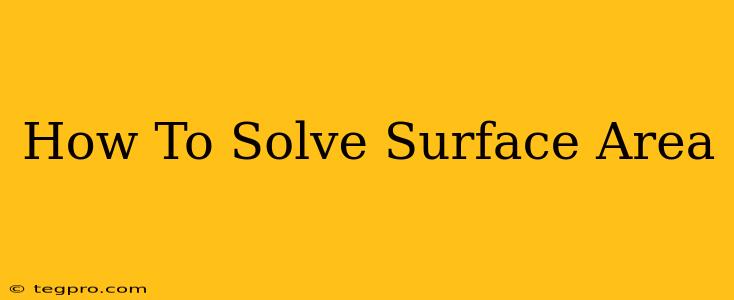Surface area calculations might seem daunting, but with the right approach and understanding, they become manageable. This comprehensive guide breaks down how to solve surface area problems for various shapes, equipping you with the skills to tackle any challenge.
Understanding Surface Area
Before diving into calculations, let's clarify what surface area means. Simply put, the surface area of a three-dimensional object is the total area of all its faces or surfaces. Imagine wrapping a present – the amount of wrapping paper needed represents the surface area of the gift. This concept is crucial in various fields, from engineering and architecture to packaging design and even biology.
Calculating Surface Area for Common Shapes
Different shapes require different formulas. Let's explore the most common ones:
1. Cube
A cube is a three-dimensional shape with six identical square faces. The surface area of a cube is easily calculated using this formula:
Surface Area = 6 * s²
Where 's' represents the length of one side of the cube.
Example: If a cube has sides of 5 cm, its surface area is 6 * 5² = 150 cm².
2. Rectangular Prism (Cuboid)
A rectangular prism, also known as a cuboid, has six rectangular faces. Its surface area is calculated as follows:
Surface Area = 2(lw + lh + wh)
Where:
- l = length
- w = width
- h = height
Example: A rectangular prism with length 4 cm, width 3 cm, and height 2 cm has a surface area of 2(43 + 42 + 3*2) = 52 cm².
3. Sphere
A sphere is a perfectly round three-dimensional object. Its surface area is determined using:
Surface Area = 4πr²
Where 'r' represents the radius of the sphere (the distance from the center to any point on the surface). Remember to use the value of π (approximately 3.14159).
Example: A sphere with a radius of 7 cm has a surface area of 4 * π * 7² ≈ 615.75 cm².
4. Cylinder
A cylinder has two circular bases and a curved rectangular surface. The surface area is calculated by adding the areas of these components:
Surface Area = 2πr² + 2πrh
Where:
- r = radius of the circular base
- h = height of the cylinder
Example: A cylinder with a radius of 3 cm and a height of 10 cm has a surface area of 2 * π * 3² + 2 * π * 3 * 10 ≈ 245.04 cm².
5. Cone
A cone consists of a circular base and a sloping curved surface. The surface area formula is:
Surface Area = πr² + πrs
Where:
- r = radius of the circular base
- s = slant height (the distance from the apex to a point on the circumference of the base).
Example: To calculate the surface area of a cone, you need both the radius (r) and the slant height (s). If r = 4cm and s = 7cm, the surface area is π(4)² + π(4)(7) ≈ 138.23 cm².
Tips for Solving Surface Area Problems
- Identify the shape: Accurately identifying the shape is the first crucial step.
- Write down the formula: This helps prevent errors and ensures you use the correct equation.
- Substitute values carefully: Double-check that you've substituted the correct values into the formula.
- Use a calculator: Especially for shapes involving π, a calculator is helpful for precise calculations.
- Include units: Remember to include the appropriate units (e.g., cm², m², in²) in your final answer.
Beyond Basic Shapes: More Complex Scenarios
While these are the most common shapes, surface area calculations can become more complex when dealing with irregular shapes or composite shapes (shapes made up of multiple simpler shapes). For these scenarios, you might need to break down the complex shape into smaller, manageable shapes, calculate the surface area of each, and then sum them together.
Mastering surface area calculations is a valuable skill. By understanding the formulas and following these steps, you'll be well-equipped to tackle a wide range of problems, whether in academic settings or real-world applications.

